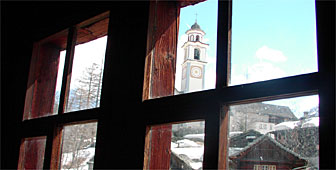Mountain village fights against the odds

At 1,506 metres above sea level, Bosco Gurin is the highest altitude village in Ticino, and the only place in the canton where the inhabitants claim German and not Italian as their mother tongue. Bosco Gurin is also struggling to survive.
Tucked away in a high valley in Ticino’s Vallemaggia region, Bosco Gurin is one of the most photographed villages in a very photogenic part of Switzerland. Its picturesque buildings, made of wood and stone with slate-roofs, cluster around a church.
Erika Della Pietra runs the village museum housed in one of the buildings. The 66-year-old woman speaks an old Swiss-German dialect that was brought to Ticino by settlers from Switzerland’s Valais region in the 13th century.
The dialect has survived despite the fact that Bosco Gurin has never had more than 500 inhabitants and has always been surrounded by Italian-speaking communities.
Population recovers
The population dipped as low as 50 in the 1990s, but has recovered slightly after large investments were made to build a couple of hotels and upgrade the village’s ski facilities, which created new jobs.
“My two girls had to go down to the valley because there was no way to earn any money here,” explains Della Pietra. “Fortunately, my son – even though he studied business management – found a job working at the ski lift, which means he can live in the village year round.”
In hopes of attracting more tourists, Grossalp, the company behind the development, has proposed building a rail tunnel through the mountain to Italy.
“The population has climbed again to nearly 100 and we hope to double that number,” says Fulvio Sartori, the director of Grossalp.
Only chance of survival
Despite fears in some quarters that the developments pose a threat to the village’s unique heritage, the majority of the inhabitants of Bosco Gurin see tourism as the village’s only chance of survival.
“If we want the village to continue we have to say yes to such plans,” says Della Pietra. “We have a museum, but we can’t afford to let the whole village become a museum, otherwise all of our young people will leave, and that would be terrible.”
When Della Pietra was a child, she migrated with her family to northern Switzerland in search of a better future. They had to learn the Swiss-German dialect of their new home, but always spoke the antiquated Gurin German among themselves.
When she returned to the village to stay for good, she became a passionate student of the dialect and knows as much as anyone about its idioms and idiosyncrasies.
The distinctive architecture of the village is as unique in Ticino as the Gurin dialect.
And the modest growth of the village as a ski resort has made it easier to find outsiders interested in owning a holiday home and who are willing to invest in the restoration work. As in canton Valais, many of the wooden buildings are propped up on short stone pillars.
“There are people who say the conservation of the village has nothing to do with tourism,” Della Pietra adds. “But I have to say that every carpenter and bricklayer would answer, ‘look at the village, thanks to tourism we can afford new doors, windows and roofs’!”
Threat from foreigners
Sartori believes that Bosco Gurin has a viable future, even though he is aware that the increase of foreigners poses a threat to the village culture.
“If we do nothing, it will surely die. If we carry out our plans, it means that young people from Bosco Gurin can stay in the village,” he says. “They can make something of their lives by staying. If we do nothing, our children will have no future here. That’s the problem.”
Della Pietra shows visitors to the museum an odd collection of wooden pegs which have been strung together. “The pegs are marked with symbols that were used when few could read or write,” she says.
“Every family had a symbol, and when someone had to go to the village council to file a complaint or make a request, they had to take the pegs with them to show which family they were from.”
The pegs were also used to draw lots when a village member was needed to tackle a dangerous job, of which there were many for those living in the midst of inhospitable mountains.
The main threat today comes from below in Switzerland’s towns and cities, where it has become relatively easy to find good and well paying work.
“We have potential here,” says Sartori modestly. “We aren’t interested in creating a large, ugly resort but to do enough so that we can survive.”
by Dale Bechtel

In compliance with the JTI standards
More: SWI swissinfo.ch certified by the Journalism Trust Initiative

You can find an overview of ongoing debates with our journalists here. Please join us!
If you want to start a conversation about a topic raised in this article or want to report factual errors, email us at english@swissinfo.ch.